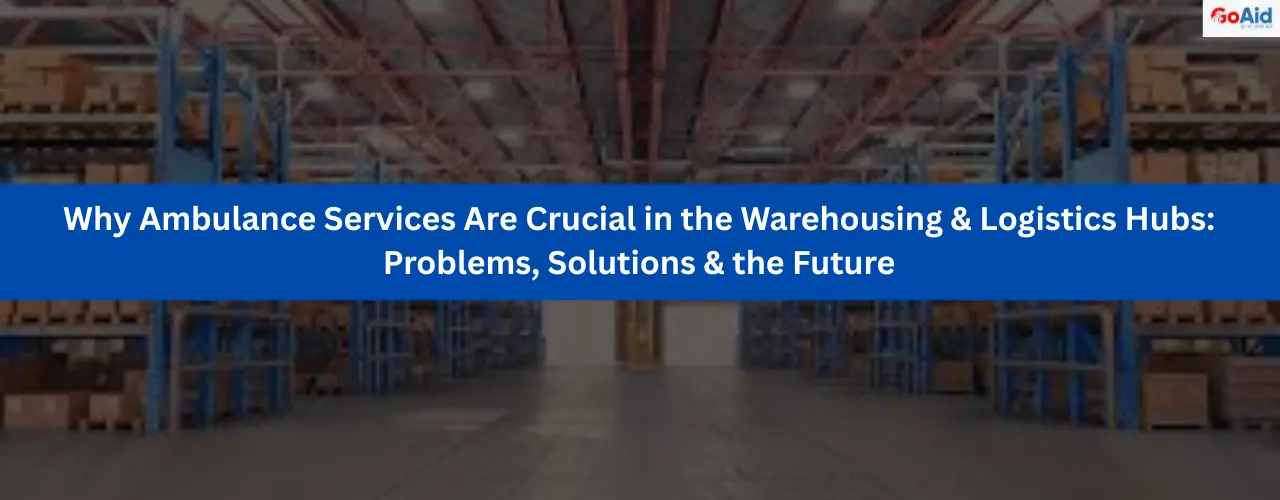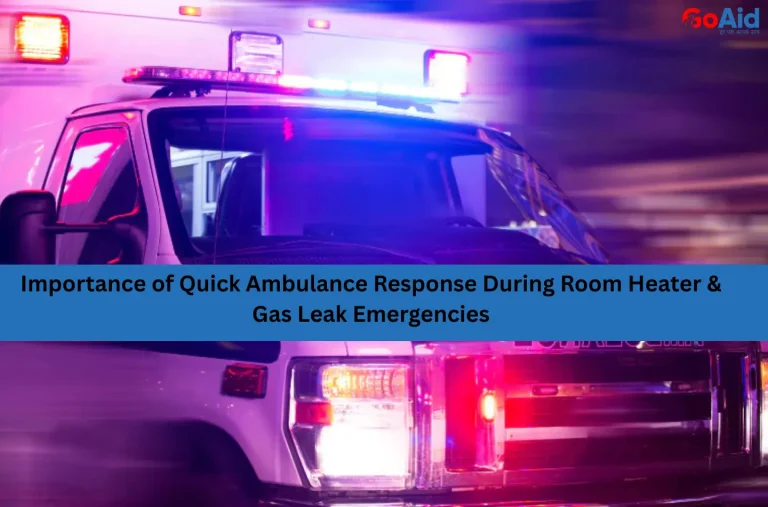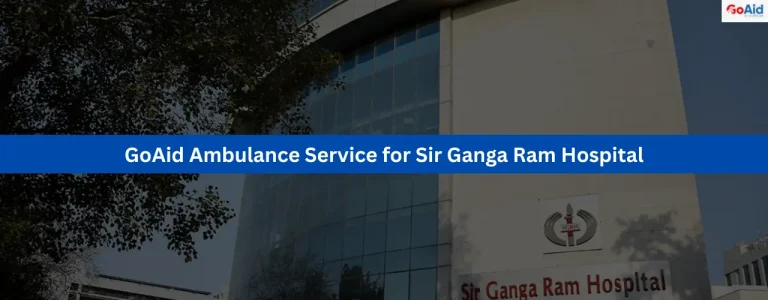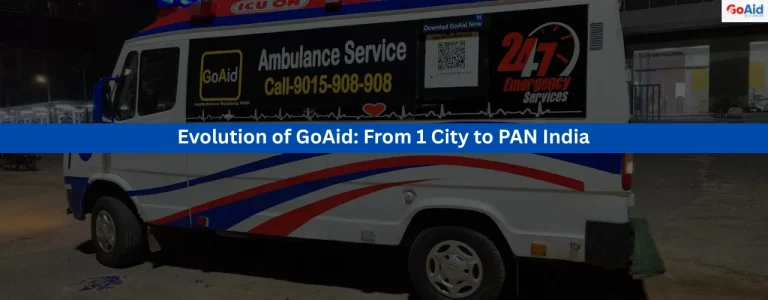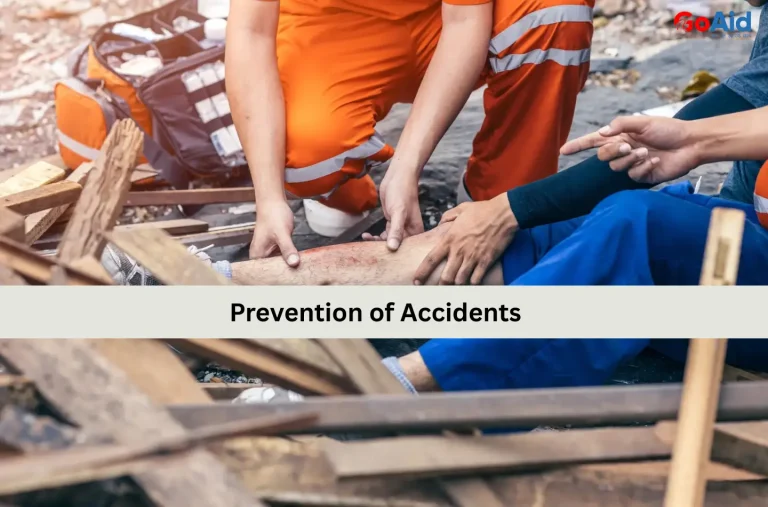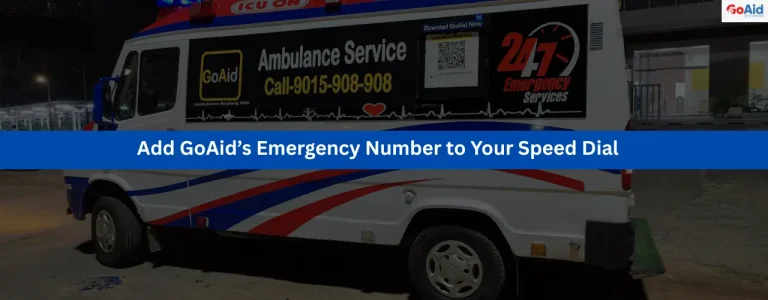Warehousing & Logistics Hubs handle heavy machinery, lifting tasks, and fast-paced operations in India. These all things increase the risk of┬Ā medical emergencies and make ambulance services for Warehousing & Logistics Hubs a critical need
This blog explains why Ambulance Services Are Essential for the Warehousing & Logistics Hubs. How can these problems be solved, and how can GoAid be used as a Reliable Partner for Warehousing & Logistics Hubs? Are you excited to read about it? If yes, then you donŌĆÖt need to wait any longer
LetŌĆÖs start reading
Common Health & Safety Problems at Warehousing & Logistics Hubs
Warehousing & Logistics Hubs face numerous health and safety challenges due to their high-risk environment and non-stop operations.
- Slip, Trip & Fall Incidents: Slips, trips, and falls are among the most frequent accidents in Warehousing & Logistics Hubs, often requiring immediate first aid on Warehousing & Logistics Hubs or emergency ambulance services.
- Manual Handling Injuries: Manual handling injuries, such as back strain or joint dislocation, are common and demand on-site ambulance service for quick assessment and transport to a hospital if needed.
- Forklift & Vehicle Collisions: Forklift and heavy vehicle collisions pose serious risks, often leading to trauma or fractures, requiring rapid emergency response in Warehousing & Logistics Hubs.
- Hazardous Substance Exposure: Exposure to hazardous substances during loading or storage operations may result in breathing issues or poisoning, demanding medical emergencies in Warehousing & Logistics Hubs.
- Heat-Related Illnesses: Heat strokes or dehydration in non-air-conditioned warehouses are regular issues, highlighting the need for an ambulance for worker safety and quick hydration treatment.
- Electrical Shock Risks: Electrical shocks from damaged equipment or cables can lead to cardiac arrest or burns, making Warehousing & Logistics Hubs’ ambulance service vital for survival.
- Sudden Medical Emergencies: Sudden medical conditions like heart attacks or seizures among staff emphasize the importance of an ambulance at Warehousing & Logistics Hubs for timely and life-saving care.
Why Ambulance Services Are Essential for the Warehousing & Logistics Hubs
In India, due to the scale and pace of operations, Warehousing & Logistics Hubs are highly vulnerable to medical emergencies. Having a dedicated ambulance for Warehousing & Logistics Hubs ensures timely care and protects worker health and productivity.
- Immediate Medical Response: On-site ambulance service enables instant response to injuries, reducing risk and downtime during critical medical emergencies in Warehousing & Logistics Hubs.
- Support During Shift Hours: Warehousing hubs operate 24/7, making 24-hour ambulance service essential for continuous emergency care during night and early-morning shifts.
- Handling Major Accidents: From forklift crashes to chemical spills, a reliable ambulance service at Warehousing & Logistics Hubs handles severe incidents swiftly.
- Boosting Worker Confidence: Knowing that medical emergency help is readily available increases worker morale and trust in the organizationŌĆÖs safety culture.
- Minimizing Transport Delays: On-site ambulance services eliminate delays in transporting patients to hospitals, ensuring faster and more effective emergency response.
- Reducing Legal & Safety Liabilities: Quick medical aid reduces the risk of non-compliance with Warehousing & Logistics Hubs safety regulations and protects from legal liabilities.
- Essential for Remote Hubs: Many logistics hubs are in remote areas; an ambulance for worker safety becomes critical where nearby hospitals may not be easily accessible.
Types of Ambulance Services Might be Required in the Warehousing & Logistics Hubs
In India, different emergencies in Warehousing & Logistics Hubs call for varied ambulance types, ensuring a tailored response depending on the situation and severity of the incident.
- Basic Life Support (BLS) Ambulance: BLS ambulances are essential for stabilizing patients with minor to moderate injuries, providing first aid on Warehousing & Logistics Hubs during transit.
- Advanced Life Support (ALS) Ambulance: ALS ambulances are required for handling severe trauma, cardiac emergencies, or serious medical conditions at Warehousing & Logistics Hubs.
- ICU Ventilator Ambulance: In critical cases such as head injuries or chemical exposure, ICU ventilator ambulances ensure continuous life support during long-distance transfers.
- Event Ambulances for On-site Coverage: Event ambulances stationed at large logistics events or high-traffic warehousing zones provide round-the-clock on-site ambulance service.
- Mortuary Van: For unfortunate fatalities, having a mortuary van ensures dignified and safe transport while complying with legal norms.
- Ambulance with Dead Body Freezer Box: These are necessary in hubs located far from urban centers to preserve the body until family or officials arrive.
- Interstate Ambulance Services: For companies operating across states, having access to long-range ambulance services ensures safe transport across regional boundaries.
Know More: Difference between BLS Ambulance and ALS Ambulance
Current Challenges in Providing Ambulance Services to Warehousing & Logistics Hubs
In India, despite the growing need, several issues still hinder the setup of reliable Warehousing & Logistics Hubs ambulance service, impacting overall emergency readiness and worker safety.
- Remote Locations: Many Warehousing & Logistics Hubs are situated on city outskirts, making timely ambulance access difficult during peak traffic or late hours.
- Limited Awareness: Employers often underestimate the need for on-site ambulance service, ignoring the frequency and severity of workplace injuries.
- Budget Constraints: Some companies skip investing in emergency infrastructure due to cost concerns, despite affordable government-approved ambulance charges being available.
- Lack of Trained Medical Staff: In remote hubs, the absence of trained paramedics and sensible ambulance helpers limits the effectiveness of emergency care.
- Delayed Response Time: Without a stationed ambulance, response times stretch due to the distance from city centers, increasing the risk to the injured.
- Poor Integration with Local Hospitals: Inadequate coordination between warehouses and nearby hospitals affects the seamless transfer and admission of emergency patients.
- Regulatory Gaps: ThereŌĆÖs a lack of strict regulation mandating ambulances at Warehousing & Logistics Hubs, which delays implementation in several private logistics setups.
How Can These Problems Be Solved?
There are several challenges in delivering effective ambulance services to Warehousing & Logistics Hubs can be overcome through strategic planning, advanced technology, and partnerships with reliable emergency service providers like GoAid.
- Deploying On-Site Ambulance Services: Stationing on-site ambulance services within the premises ensures immediate emergency response in Warehousing & Logistics Hubs, reducing transport delays and saving lives during critical incidents.
- Emergency Training for Staff: Providing regular first aid and emergency response training empowers workers to manage initial care before professional help arrives, ensuring better outcomes in medical emergencies.
- Partnering with Ambulance Providers: Collaborating with dedicated providers like GoAid enables access to Warehousing & Logistics Hubs ambulance service, including ALS, BLS, and ICU-equipped vehicles.
- Government Regulation Compliance: Adhering to Warehousing & Logistics Hubs’ safety regulations, including having emergency medical infrastructure, helps avoid penalties and ensures worker protection.
- Budget Allocation for Safety: Investing a fixed safety budget for ambulance infrastructure ensures long-term savings by reducing accidents and legal liabilities.
- Mobile App-Based Booking Systems: Quick ambulance access via apps like GoAid enhances response time, especially in large or remote logistics locations.
- Centralized Emergency Coordination: Establishing a dedicated emergency control room at major hubs helps track incidents, manage dispatches, and improve coordination with local hospitals.
Future of Emergency Medical Services in Warehousing & Logistics Hubs
As Warehousing & Logistics Hubs continue to grow in size and complexity, the demand for advanced emergency medical services will also rise. Future-ready hubs will integrate smart technologies like IoT-based incident detection, GPS-enabled ambulance tracking, and AI-driven response systems. These innovations will ensure faster, data-backed medical interventions, minimizing downtime and increasing worker safety. Warehousing companies will also be expected to offer better healthcare infrastructure to remain compliant with stricter government safety norms.
In the coming years, ambulance services for Warehousing & Logistics Hubs will likely evolve into a hybrid system of on-site rapid response units and mobile ICU-equipped ambulances. Dedicated emergency lanes, interstate coverage, and 24/7 availability will become standard across hubs. Partnerships with specialized providers like GoAid will play a pivotal role in managing health risks. The focus will shift from reactive care to proactive emergency preparedness, ensuring that logistics operations never compromise on human safety.
Legal Obligation for On-Site Ambulances in India
In India, under labour laws and evolving corporate norms, maintaining on-site ambulance service is not just a safety measure but a legal and ethical responsibility for Warehousing & Logistics Hubs. It directly supports worker welfare and reflects corporate social responsibility.
- Factories Act Compliance: According to the Factories Act, large facilities must have first aid and emergency medical services, making ambulance for Warehousing & Logistics Hubs a mandatory requirement.
- Labour Law Regulations: Labour safety laws in India urge companies to ensure medical emergency care, especially in hazardous working environments like Warehousing & Logistics Hubs.
- ESIC Coverage Needs: ESIC mandates quick emergency care for insured workers. On-site ambulances fulfill this legal obligation and improve injury response in logistics zones.
- CSR Policy Alignment: Providing Warehousing & Logistics Hubs ambulance service aligns with a companyŌĆÖs CSR goals and builds a responsible brand image among stakeholders.
- Worker Health Protection: Ambulance access ensures emergency care in case of injury or illness, boosting workforce health and satisfaction in logistics environments.
- Audit and Inspection Readiness: Having on-site emergency setups helps companies comply during safety audits or inspections by regulatory authorities.
- Injury Risk Mitigation: Fulfilling this obligation ensures that any medical emergency in Warehousing & Logistics Hubs is managed quickly, reducing the risk of fatality or long-term disability.
How Can GoAid Be Used as a Reliable Partner for Warehousing & Logistics Hubs?
GoAid is a trusted provider of emergency medical services across India, making it an ideal partner for enhancing ambulance services in Warehousing & Logistics Hubs through reliability, speed, and nationwide support.
- 10-Minute Response Time: GoAid guarantees ambulance dispatch within 10 minutes, ensuring swift emergency response in Warehousing & Logistics Hubs, even in remote industrial areas.
- Diverse Ambulance Fleet: From BLS to ICU ambulances and freezer vans, GoAid provides various vehicle types to suit all medical emergencies in Warehousing & Logistics Hubs scenarios.
- 24/7 Availability: GoAid operates day and night, offering round-the-clock ambulance services for Warehousing & Logistics Hubs to match the 24/7 nature of logistics operations.
- App & Helpline Booking: Quick bookings via the GoAid App or by calling 8008280020 make it easy for warehouses to access on-site ambulance service anytime.
- Experienced Paramedics: GoAid deploys skilled paramedics and helpers trained in industrial emergency care, enhancing the quality of ambulance for worker safety.
- Interstate Ambulance Support: With interstate service capability, GoAid handles transfers from remote hubs to specialty hospitals across state borders.
- Cost-Effective & Approved Rates: GoAid follows government-approved ambulance charges, ensuring affordable services aligned with CSR and compliance goals.
Case Studies
Adani Logistics Hub Ambulance Integration:
Adani Group has prioritized worker safety by integrating dedicated ambulance services for Warehousing & Logistics Hubs across its logistics centers. Partnering with trusted ambulance providers, they ensure rapid on-site ambulance service 24/7, addressing emergencies such as forklift accidents and manual handling injuries. Their modern ambulance fleet, staffed with trained paramedics, provides timely emergency care that reduces injury downtime and enhances overall Warehousing & Logistics Hubs safety. AdaniŌĆÖs approach exemplifies how robust ambulance infrastructure supports operational efficiency and meets regulatory requirements.
Tata GroupŌĆÖs Warehousing Medical Emergency Preparedness:
Tata Group mandates comprehensive Warehousing & Logistics Hubs, ambulance service at all major warehousing facilities. Utilizing app-based ambulance booking and GPS tracking, they guarantee fast response times for any medical emergency in Warehousing & Logistics Hubs. Equipped with advanced ambulances and skilled paramedics, TataŌĆÖs system reduces legal liabilities and ensures worker health protection. This strong focus on emergency readiness highlights TataŌĆÖs commitment to safety, compliance, and corporate social responsibility, serving as a benchmark for effective emergency management in logistics hubs.
Conclusion to the Need for Ambulance Services in Warehousing & Logistics Hubs
The fast-paced and high-risk environment of Warehousing & Logistics Hubs makes having reliable ambulance services essential for safeguarding worker health and ensuring uninterrupted operations. Quick access to emergency care minimizes the impact of accidents, improves recovery times, and strengthens workplace safety culture. Moreover, on-site ambulance availability addresses legal obligations and reflects a companyŌĆÖs commitment to worker welfare and corporate social responsibility.
As logistics hubs expand across India, investing in comprehensive ambulance for Warehousing & Logistics Hubs is not optional but a necessity. Leveraging professional services like GoAid can help hubs manage medical emergencies efficiently with modern ambulances, skilled paramedics, and rapid response systems. Ultimately, prioritizing ambulance services ensures safer work environments and enhances overall productivity in this critical sector.
Call-to-Action (CTA)
Ensure the safety of your Warehousing & Logistics Hubs with reliable ambulance services. Partner with GoAid for fast, government-approved, and 24/7 emergency care solutions tailored to your industrial needs. Book now for peace of mind!
FAQs on the Need for Ambulance Services in Warehousing & Logistics Hubs
Question 1: Why are ambulances needed at Warehousing & Logistics Hubs?
Answer: Ambulances provide rapid emergency care for injuries common in warehousing environments, minimizing fatal risks and ensuring timely medical attention for workers.
Question 2: What types of injuries are common in the Warehousing & Logistics Hubs?
Answer: Common injuries include slips, falls, equipment accidents, heat stress, cuts, fractures, and overexertion, all requiring immediate first aid or ambulance services.
Question 3: Is it mandatory to have ambulance services at Warehousing & Logistics Hubs in India?
Answer: Yes, Indian labour laws and safety regulations require warehouses to provide on-site emergency medical support, including ambulance services for worker safety.
Question 4: Can private companies provide ambulance services to Warehousing & Logistics Hubs?
Answer: Absolutely, private ambulance providers like GoAid offer reliable, government-approved services tailored to the emergency needs of logistics hubs.
Question 5: What should a Warehousing & Logistics Hub look for in an ambulance service provider?
Answer: Look for quick response times, well-equipped ambulances, trained paramedics, 24/7 availability, government approval, and affordable rates.
Question 6: What is an on-site ambulance service?
Answer: On-site ambulance service means having ambulances stationed within or near the warehouse premises for immediate emergency medical response.
Question 7: How does an ambulance service improve worker safety in Warehousing & Logistics Hubs?
Answer: Ambulance services ensure quick medical intervention, reduce injury severity, support compliance, and boost overall worker confidence in safety protocols.
Question 8: Are there any legal obligations for emergency medical support at Warehousing & Logistics Hubs?
Answer: Yes, laws like the Factories Act and labour safety regulations mandate emergency medical facilities, including ambulances, for worker protection.
Question 9: How much does hiring an ambulance service for a Warehousing & Logistics Hub cost?
Answer: Costs vary by service type and location, but government-approved and affordable packages from providers like GoAid ensure value without compromising quality.
Question 10: Do ambulance providers offer trained paramedics along with the vehicle?
Answer: Yes, professional ambulance services come with skilled paramedics trained to handle industrial emergencies in Warehousing & Logistics Hubs.
Question-11: Can ambulances be equipped with trauma kits for Warehousing & Logistics Hubs-related injuries?
Answer: Absolutely, ambulances servicing warehouses are equipped with trauma kits, ventilators, oxygen, and other critical emergency medical equipment.
Question 12: How fast can an on-site ambulance respond compared to city emergency services?
Answer: On-site ambulances typically respond within 10 minutes, much faster than city emergency services, ensuring quicker care in Warehousing & Logistics Hubs.
Question 13: How does having an ambulance affect insurance and liability claims?
Answer: Immediate ambulance care can reduce injury severity, which helps in faster insurance claims and lowers liability risks for the company.
Question 14: Is a 24/7 ambulance service necessary for Warehousing & Logistics Hubs?
Answer: Yes, since logistics hubs operate around the clock, 24/7 ambulance availability is critical for continuous emergency readiness.

